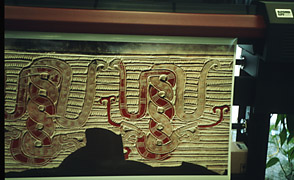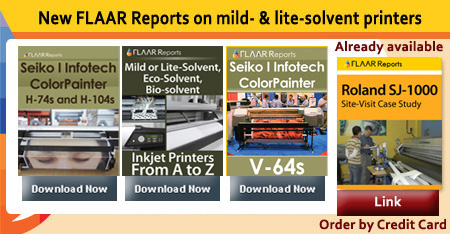Reviews of ColorSpan DisplayMaker XII wide format printer.
At last a wide format printer that produces photographic quality enlargements at production speeds. Other printer companies hype their speed, which in an actual printing environment cannot be reproduced (it's called junk mode). Draft mode means "throw away mode." We had to throw away most of the output from Epson piezo printheads at their much touted "speed." In real life they are the slowest printers available. Yes, an Epson produces nice output at photo mode, but it's too slow for a commercial sign company or photo lab. A Roland can take up to 2 hours in its 8-color mode at 32 pass photo quality.
Look instead at the impressive results from a ColorSpan wide format printer. ColorSpan is a company which grew out of LaserMaster, well known for their advanced laser printers in a previous era. ColorSpan now makes a printer that can do floor graphics, backlit signs, murals, trade show displays, point of purchase (POP) signage, as well as posters, banners, and typical wide format products.
This kind of printer is especially good choice for a professional photo studio (photo lab), print shop, copy center, or advertising bureau. Just be sure that you realize you may prefer to have an extended warranty as backup security (which can cost several thousand dollars). Three years ago this was the message. The warranty is needed for as long as you own the printer, since you may need technical help and replacement of parts that don't function well. ColorSpan is a complex technical printer. But quickly we learned that most of the problems were in the years when the company was owned by Virtual Fund (venture fund companies are sometimes jokingly called the Vulture Fund).
Two years ago ColorSpan was bought by a new company, MacDermid. The new MacDermid ColorSpan has an entirely new policy of taking better care of the customer and attending to maintenance and service. I have kept an eye on ColorSpan, the company and its printers, for several years. The newest model, the Esprit, costs half of previous models and gives the same legendary quality.
ColorSpan makes a wide selection of fine printers. The one pictured here is the Ilford IJT from Ilford Imaging. My first experience with the ColorSpan DisplayMaker was their HiRes model with 8-color technology. The 8-colors are what give it the High Resolution. Agfa marketed the ColorSpan under the name Agfa Montana. Since November 2001, ColorSpan is sold only by ColorSpan, not by Ilford or Afga. In Latin America, however, may still be distributed by Xerox.
During the test what impressed me the most was how true the colors are when printed on the ColorSpan. Unfortunately the flash used to take this snapshot was not wide enough to cover the field of view of the wide angle lens. This was our first experience with a ColorSpan, 4 years ago. |

|
Don't try to buy one of these printers over the internet and try to install it yourself. A ColorSpan is a printer where you need the printer, the RIP, the media, the inks, and all their ICC profiles together in one package. This is an integrated system, the only way to set up a printer of this nature.
Take the speed statistics with a grain of salt (which means reduce them considerably). Remember the rule, fast speed = low dpi, low dpi = less quality. Hence, fast speed = less quality.
Naturally what you want is slow speed = the highest quality. The ads show you the high quality, brag a bit about the high speed, and the reader loses track and presumes the high quality is of course also available at the high speed. No, its not like that.
If you are good with electronics, if you have already run a printing company (with traditional presses), or if your company is large enough to have a person who likes to work on equipment such as a ColorSpan printer, then you should consider this printer. We recommend, however, a factory-new printer. If a demo or reconditioned, then we recommend under the agreement (written agreement) that it will be replaced or purchase price refunded in full if the printer does not function as advertised. ColorSpan itself will provide a service agreement with any of its older models, even original models dating to years ago.
Since FLAAR does evaluations, we figured it made more sense to evaluate a demo unit, one that had already been around for a while. This provided the added test results of knowing whether a reconditioned ColorSpan would hold up. So far it does just great. We don't have a single complaint. Works fine every time.
What are your alternatives? Roland offers good quality but much slower. Roland is supposed to run around the clock, which is why it costs more than the Epson. Downside is the Roland's propensity to banding, printhead disabilities, and slowness. This can pop up at any time and ruin your images. Roland's pigmented inks have a notoriously poor color gamut (you can tell, that's why the ads tout color, to overcome this problem). Epson does the same, if anything about their printer is not very impressive, the ad agency singles out that aspect and claims Epson is the absolute best in this specific attribute (now you know why Epson ads claim its fast and can print on all kinds of media). That's because Epson's are slow and have a renowed inability to print on most media other than their own.
Another alternative is the HP 3000, 3500, or 3800CP, after all, these models use the same heads as the ColorSpan DisplayMaker XII. ColorSpan is wider, somewhat faster, and noticeably higher dpi. An HP 5500 would be comparable to the Mach 12 or X12. But ColorSpan offers ability to print on thick media; with the Esprit you can print on thicker and stiffer media. Mach 12 will take thick watercolor paper which won't fit through any HP. Plus ColorSpan offers 8 colors for wider gamut and better depth of color. Actually we use both brands: we have two HP 5000's and two ColorSpan's. Use them both: HP for pigmented; ColorSpan for dye inks.
The new Esprit model of ColorSpan changes this. Now you get the same quality (eight colors) yet for the price of an HP DesignJet. Of course HP itself has upped the ante by producing its own 1200 dpi six color printer, the HP 5000ps.
If you want to knock people's eyes out with quality, at an art exhibit, trade show, or whatever, then you need those extra dpi offered by ColorSpan's six, eight, or twelve-ink capability. If you have read a lot of the FLAAR reviews you can probably note that my favorite for entry-level through mid-level is the HP and my favorite for high-end is the ColorSpan. I like the Roland and Epson but if I won the lottery and could afford any printer I would opt for a ColorSpan in the inkjet category. If I won a second lottery, then I would also want a Cymbolic Sciences LightJet or Durst Lambda (about a quarter of a million dollars). In comparison the ColorSpan is a bargain.
ColorSpan makes a range of impressive printers, from the the 12 color DisplayMaker Series 12 wide format printer to the Esprit and the newer Mach 12. ColorSpan also makes the Giclee PrintMakerFA for Fine Art printing. The DisplayMaker Series XII offers an apparant 1800 dpi color print.
For museums a printer such as this would be an asset in fund raising. Museums could do exhibits more economically if the curators and in-house photo staff had access to a wide-format printer. With a local network everyone in the building can easily print from a single printer. Just send your files over the network.
A ColorSpan Displaymaker XII has been in the FLAAR facility at Bowling Green State University of Ohio for about five months. One of the many torture tests we subject all printers to is allowing them to sit unused for over a month. This test totally clogged the piezo printheads of the Epson 7500. But with the ColorSpan, we turned it on after over a month of this silent test, and after doing its test strip, the printer produced museum quality output.
I would like to point out that we have no technician working on this ColorSpan printer. Actually the students use it; they received no training whatsoever. Part of the test is to have them read the instruction book and get the printer going on their own. And they did it, flawless printing. Yes, they had a few headaches since they had never even seen this printer operating before I sprung the test on them. Each one had the ColorSpan up and running within their first day. We did this three times on the DisplayMaker XII and now do it already as a test on the Mach 12. So surely you too will find this printer a capable production machine in your sign shop, photo studio, or in-plant print facility.
After this print, I asked one of the instructors his opinion. He has considerable professional experience in Europe as well as in the USA, and is in the PhD program in printing technology. His main experience is with the Iris printer. He looked carefully at the output (and this was after the printer had been unused over a month, actually it may have been close to two months). And his eyes lit up when he saw the output, as he said, "This is the most beautiful large format print I have ever seen."
That's the "ooh and aahh" test. People complain that we don't use complex instruments to measure the output. But why?
When you run a printshop, it is meaningless what some testing institute says about color longevity under instrumentation. What counts is quite blunt, do your clients like your print job? Does your print work look better than that of the competition who use a lesser printer?
At normal viewing distance of 3 feet the output from the ColorSpan DisplayMaker XII has won every ooh and aahh quality test in the last three years in the FLAAR printshop. We now have the Mach 12 but still use the DisplayMaker XII every day. This month ColorSpan introduced an upgrade model, the X12.
If you need help deciding what wide format color printer to buy, send an e-mail to the review editor, Nicholas Hellmuth, contact Please be sure to mention what kind of images you reproduce, what your market is, your level of experience such as whether you are new to digital printing, and what printers did you consider before reading the reviews on this site. Indicate roughly your budget since it makes little sense to lust after a printer that is overly costly. We prefer to recommend cost-effective printers that produce photo-realistic quality with long-lasting colors using archival inks.
Most recently updated November 25, 2001.
Previous updates: Nov. 12, 2002.
 |